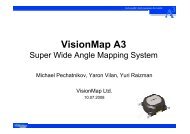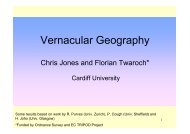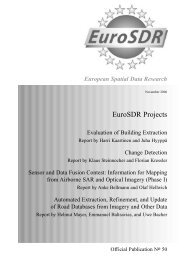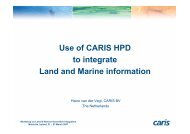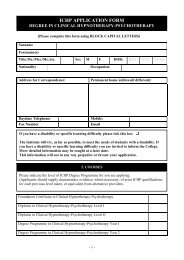the UK Vertical Offshore Reference Frame - EuroSDR
the UK Vertical Offshore Reference Frame - EuroSDR
the UK Vertical Offshore Reference Frame - EuroSDR
You also want an ePaper? Increase the reach of your titles
YUMPU automatically turns print PDFs into web optimized ePapers that Google loves.
A Tale of Many Datums: <strong>the</strong> <strong>UK</strong><br />
<strong>Vertical</strong> <strong>Offshore</strong> <strong>Reference</strong> <strong>Frame</strong> -<br />
VORF<br />
Dr Marek Ziebart and Dr Jonathan Iliffe<br />
Department of Geomatic Engineering<br />
University College London<br />
<strong>EuroSDR</strong> meeting, Malahide, Ireland March 2007
Presentation structure<br />
• What is VORF?<br />
• Why do we need it?<br />
• Model development<br />
• Interface and software functionality<br />
• Applications<br />
• Project status and initial test results<br />
• Conclusions
What is VORF?<br />
• A high resolution digital model of all <strong>the</strong> reference<br />
surfaces in all navigable waters of <strong>the</strong> British Isles.<br />
All surfaces are modelled with respect to <strong>the</strong> GPS<br />
global datum (WGS84/ITRF2000, ETRF89)<br />
• The software to transform rapidly and robustly<br />
between <strong>the</strong>se different datums.
VORF surfaces:<br />
Newlyn<br />
(OD o<strong>the</strong>r)<br />
ETRF89/GRS80 Ellipsoid<br />
Land and Sea datums related to each o<strong>the</strong>r<br />
HAT<br />
MHWS<br />
MSL2000<br />
MLWS<br />
LAT<br />
Chart Datum<br />
Common to all
Basic VORF functionality:<br />
Transforming data between vertical datums<br />
Example: Chart Datum to MLWS<br />
Sea floor<br />
GRS80 Ellipsoid<br />
New data set in MLWS<br />
Existing survey<br />
expressed in CD<br />
MLWS<br />
Chart Datum
Why is VORF needed?<br />
• Continuing developments in GNSS<br />
• LIDAR and multibeam technology<br />
• Global trends in datum unification, harmonisation<br />
of charting, automation in navigation and data<br />
acquisition
Why is VORF needed:<br />
Current practice for bathymetry data processing<br />
Tide gauge<br />
observed tide<br />
(and time)<br />
Problems:<br />
Complexity – onshore and<br />
offshore operations, time<br />
Latency – <strong>the</strong> process takes<br />
time and hence is expensive<br />
Use co-tidal<br />
chart<br />
derived from<br />
depth<br />
measurement<br />
(and time<br />
of observation)<br />
survey vessel<br />
Tidal correction<br />
Charted depth<br />
Low accuracy – co-tidal charts have limited resolution and are<br />
derived from limited data; seabed gauges are expensive<br />
Inconsistent – practices using Chart Datum are poorly defined<br />
and can lead to discrepancies<br />
LAT<br />
… or use<br />
seabed gauge
Bathymetry data processing with VORF and GPS<br />
Key benefits:<br />
• Speed of deployment – no<br />
reliance on tide gauges or<br />
need to transfer Chart Datum.<br />
• Consistency and quality<br />
control<br />
• Rapid turnaround of surveys.<br />
• Rapid response to<br />
emergencies<br />
GRS80 Ellipsoid<br />
Tidal correction =<br />
h ε – VORF CD<br />
depth<br />
measurement<br />
h ε<br />
- accessible everywhere via GPS<br />
survey vessel (+GPS)<br />
Tidal correction<br />
CD<br />
Charted depth<br />
VORF<br />
CD
Data sources (1):<br />
.<br />
Permanent . Service<br />
for .<br />
Mean Sea Level<br />
Tide Gauge data<br />
• National Tidal and Sea<br />
Level Facility stations<br />
• High quality continuous<br />
observations<br />
• Low spatial density
Data sources (2):<br />
Admiralty Tide Table<br />
Tide Gauges<br />
Primary and secondary tide<br />
gauge data.<br />
Good spatial density.<br />
Low precision due to short<br />
term data series.
Data sources (3): Satellite Altimetry<br />
Altimetry ground tracks<br />
ENVISAT<br />
TOPEX<br />
JASON<br />
GFO<br />
ERS1/2
Data sources (4): GRACE gravity field
Data sources (5): OSGM05 – <strong>the</strong> latest <strong>UK</strong><br />
gravity field model
Developing VORF (in one slide)<br />
MSL<br />
Land datums<br />
Tide gauge<br />
observations<br />
Satellite altimetry: sea level measured<br />
directly from space<br />
Sea surface topography<br />
= MSL - geoid<br />
Interpolate sea surface<br />
Tide gauge topography<br />
MSL<br />
Tidal modelling<br />
Ellipsoidal height of<br />
mean sea level at coast<br />
CD<br />
MLWS<br />
MHWS<br />
LAT<br />
Ellipsoidal height of tide gauge from GPS<br />
Altimeter<br />
measurements<br />
geoid<br />
HAT<br />
Ellipsoidal height<br />
of Ellipsoidal satellite from height<br />
of GPS open oceans<br />
Ellipsoid
Modelling: Interpolation of surfaces
Tidal modelling<br />
Numerical models<br />
assessed by comparison<br />
with tide gauges.<br />
Best in open seas.<br />
Require modification in<br />
shallow water, coastal<br />
areas, etc.
Modelling: Chart Datum<br />
• VORF unifies all <strong>the</strong>se<br />
separate datums into<br />
one, seamless surface<br />
• Process involves<br />
verifying <strong>the</strong> link between<br />
CD and OD (<strong>the</strong> OS land<br />
height datum)
Modelling: Chart Datum interpolation<br />
CD<br />
MHWS<br />
MSL<br />
LAT<br />
ETRF89 0
Modelling: Chart Datum offset from modelled tide
Modelling: Errors<br />
Far from tidal modelling and tide<br />
gauges – flag to users of VORF with<br />
error statistics.<br />
Connected via MLWS and not<br />
levelled to ODN. Reflect in error<br />
statistics.
Science results (1): Mean Sea Level model 2000<br />
above GRS80/ETRF89<br />
• High spatial resolution<br />
model of mean sea<br />
surface directly compatible<br />
with GPS navigation<br />
• Tightly controlled and<br />
estimated using multiple<br />
observation types
Science results (2): New <strong>UK</strong> Sea Surface<br />
Topography Model<br />
• Sea surface topography<br />
model for inshore and<br />
offshore waters<br />
• Successful conclusion of<br />
<strong>the</strong> largest ‘research’<br />
element of project
VORF software functionality<br />
• Transformation between datums<br />
• Estimated error in<br />
transformations<br />
• Visualisation<br />
• User error detection<br />
• Point/file mode data import<br />
• On screen digitisation<br />
• Deals with complexity of<br />
searching for special cases<br />
such as rivers and impounded<br />
datums.<br />
• High speed data retrieval and<br />
processing.
Point in Polygon (PiP) Test<br />
Requirements<br />
• Transformation process requires PiP<br />
validation of allowable transforms<br />
• Hydrographic data => huge data<br />
volumes (multi Gb)<br />
• Conventional approach could make<br />
VORF unusable<br />
• UCL has developed new concept in<br />
high performance PiP tests<br />
• Technique based on quadtree<br />
subdivision of analysis space
Ultra Rapid Point in Polygon<br />
(PiP) Benchmark Tests<br />
• 400,000 line segment polygon<br />
set<br />
• Conventional desktop PC (1 Gb<br />
RAM, 3 GHz processor)<br />
• 8,000,000 queries carried out<br />
correctly in 16 seconds<br />
(including file reading)
<strong>Offshore</strong> Height from GPS/GNSS?<br />
• For survey applications VORF is ineffective without accurate<br />
ellipsoidal height estimates of <strong>the</strong> vessel<br />
• Conventional DGPS gives low precision height, but:<br />
• C-NAV capabilities (height uncertainty ~10 cm)<br />
• Long range RTK modelling (height uncertainty more confidence for<br />
safety critical applications
Applications: Cost and Efficiency of Surveys<br />
• Reduces complexity in survey operations<br />
• Enables easier access to a consistent, seamless<br />
datum<br />
• Enhances quality control<br />
• Reduces costs
GIS applications – coastal zone projects<br />
Chart Datum B<br />
OD Stornoway<br />
Wildlife<br />
conservation area<br />
Chart Datum A<br />
Site of new wind farm?<br />
Chart Datum C<br />
SSSI<br />
Linking land and sea data<br />
OD Newlyn
Applications: Dealing with non-Chart Datum<br />
source data<br />
• Some modern data<br />
acquisition systems present<br />
data directly in GPS datums<br />
• SHOALS LIDAR data<br />
records coastline and<br />
shallow water topography<br />
• VORF enables direct<br />
merging of LIDAR data with<br />
hydrographic databases
Summary of VORF advantages<br />
• VORF derives continuous surfaces, with fixed reference to<br />
ETRF89.<br />
• It provides a consistent interpolation between Chart<br />
Datums, and methodology for extrapolation offshore.<br />
• It eliminates some of <strong>the</strong> reliance on remote or expensive<br />
tidal observations.<br />
• It has <strong>the</strong> potential to be built in to real-time applications.<br />
• It fully exploits current and future GNSS technology, and is<br />
<strong>the</strong> basis for future accuracy enhancements.
Status and initial test results<br />
• Technology demonstrator delivered to <strong>UK</strong>HO<br />
December 2006<br />
• Proof of concept established<br />
• Tests of precision, stability, functionality and<br />
performance all complete<br />
• Areas of model weakness identified and remedial<br />
actions quantified<br />
• Interest shown by GPS receiver manufacturers<br />
• Initial sea trials carried out
Accuracy –<br />
how well has all this worked so far?<br />
• Tests of interpolating and extrapolating sea level<br />
• LAT/Chart Datum comparison<br />
• Initial sea trials
Interpolating/predicting sea level at a point<br />
Knowing sea level at <strong>the</strong>se points<br />
we needed to work out <strong>the</strong> sea level<br />
at some o<strong>the</strong>r point<br />
Fundamental ma<strong>the</strong>matical<br />
building block in VORF<br />
Test:<br />
1. Remove known stations from dataset<br />
2. Use <strong>the</strong> o<strong>the</strong>rs to predict <strong>the</strong> value<br />
3. Compute known – predicted<br />
4. Repeat this all around coast<br />
5. Compile statistics<br />
RMS prediction error around<br />
whole <strong>UK</strong> coast = 7 cm
LAT quality test<br />
• LAT - Chart Datum as<br />
proxy of LAT accuracy<br />
• Not a perfect test, but<br />
representative<br />
• Data gaps on west coast of<br />
Ireland and Scotland<br />
cause problems – but can<br />
be fixed<br />
• Most of service volume<br />
meets specification<br />
• Most coastal problems<br />
resolved by modelling –<br />
graphic is pessimistic
First Sea Trials<br />
• Survey carried out off Thames estuary<br />
• Conventional approach used: Tide gauge at coast<br />
and co-tidal charts used to reduce soundings<br />
• Soundings also reduced using GPS/VORF<br />
• No significant bias between two surveys<br />
• RMS scatter in differences ~ 7 to 9 cm<br />
• Strong validation of concept
Conclusions<br />
• VORF: a research and technology demonstrator –<br />
concept has been proven to work<br />
• GNSS navigation and positioning is becoming ubiquitous<br />
• VORF links <strong>UK</strong>HO data and products directly to GNSS<br />
positioning and measurement technologies – and copes<br />
with vast data volumes<br />
• VORF is an enabling technology<br />
• Surveying without tide gauges – cheaper, faster, more<br />
accurate<br />
• Lidar data – transform directly from WGS84 to<br />
CD/Newlyn<br />
• Most importantly: VORF joins <strong>the</strong> land and <strong>the</strong> sea –<br />
data sets/measurement techniques/services, all can be<br />
integrated



